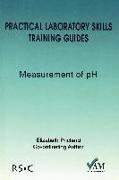- Start
- Practical Laboratory Skills Training Guides
Practical Laboratory Skills Training Guides
Angebote / Angebote:
Whether pH is being used to test a sample against a legal requirement
or specification, as part of an analytical method, for monitoring and
controlling a reaction, as a process control in the chemical industry,
or for the environmental monitoring of waste and effluents, it is
important that all pH measurements are carried out in a logical and
consistent manner, paying careful attention to experimental
procedures, in order to obtain reliable results. This guide provides
scientists with the knowledge of how to do just that, first by
outlining the principles of pH measurement and buffer solutions. pH
meters and electrodes are then discussed, including selection criteria
and the care of electrodes. Finally, sections on making pH
measurements and uncertainty are followed by a set of practical
exercises.
"Measurement of pH" is one of the "Practical Laboratory Skills
Training Guides", a series that aims to make achieving best practice
easy. These invaluable manuals will enable both experienced and
inexperienced staff to get the essential basics of any experiment
right simply by following the clear and easy to use instructions
provided. The guides are written by experienced scientists and
include minimal theory, plenty of practical exercises in order to
assess competence, and trouble shooting information. TOC:What is pH? / Why is pH measured? / Principles Underlying the
Measurement of pH / Buffer Materials with Reference pH Values / pH
Meters / pH Electrodes / Care of pH Electrodes / Selection of a pH
Electrode for a Particular Application / Making pH Measurements /
Uncertainty of pH Measurements Using a Glass Electrode / The Use of
Indicator Papers to Measure pH / Practical Exercises.
Folgt in ca. 15 Arbeitstagen
